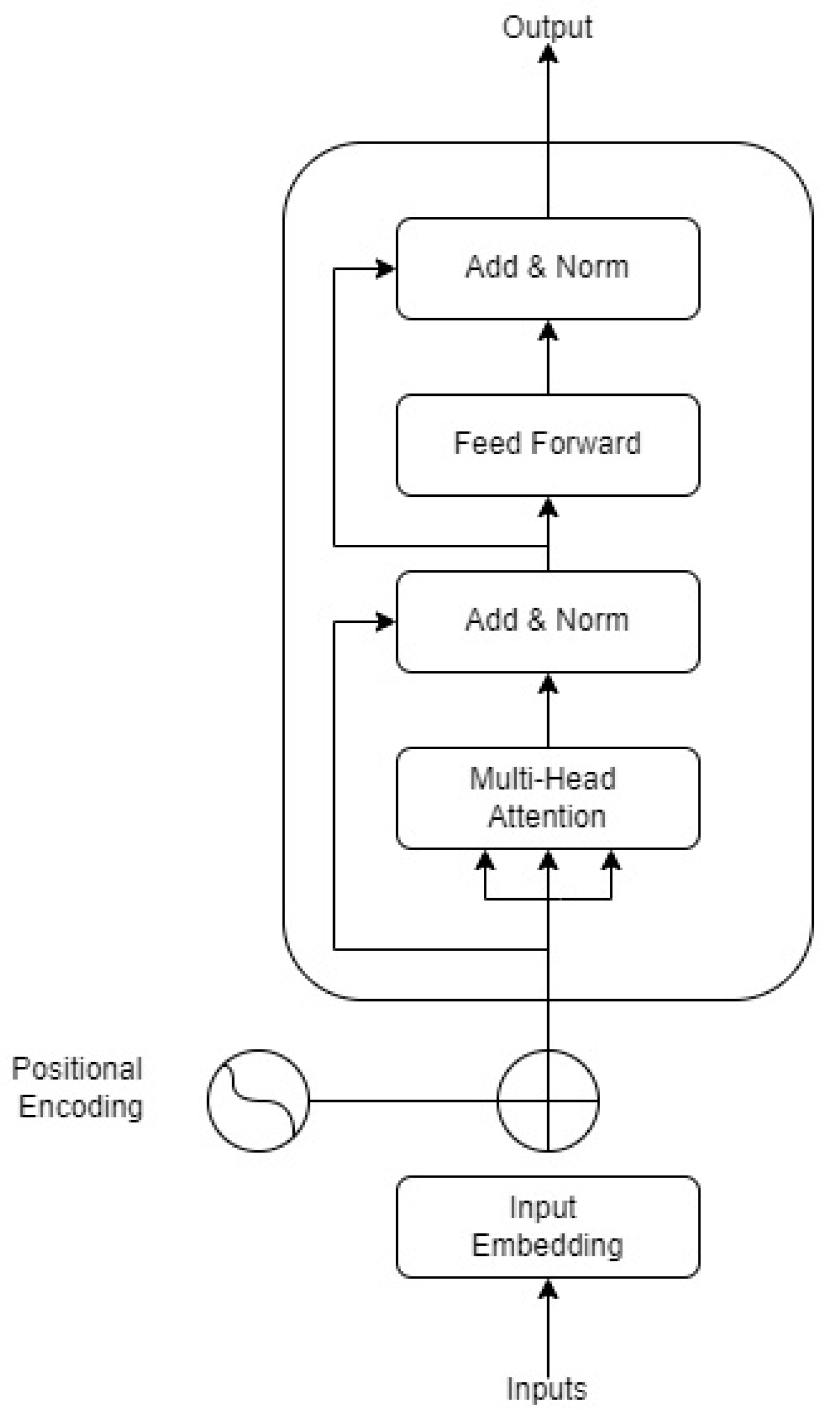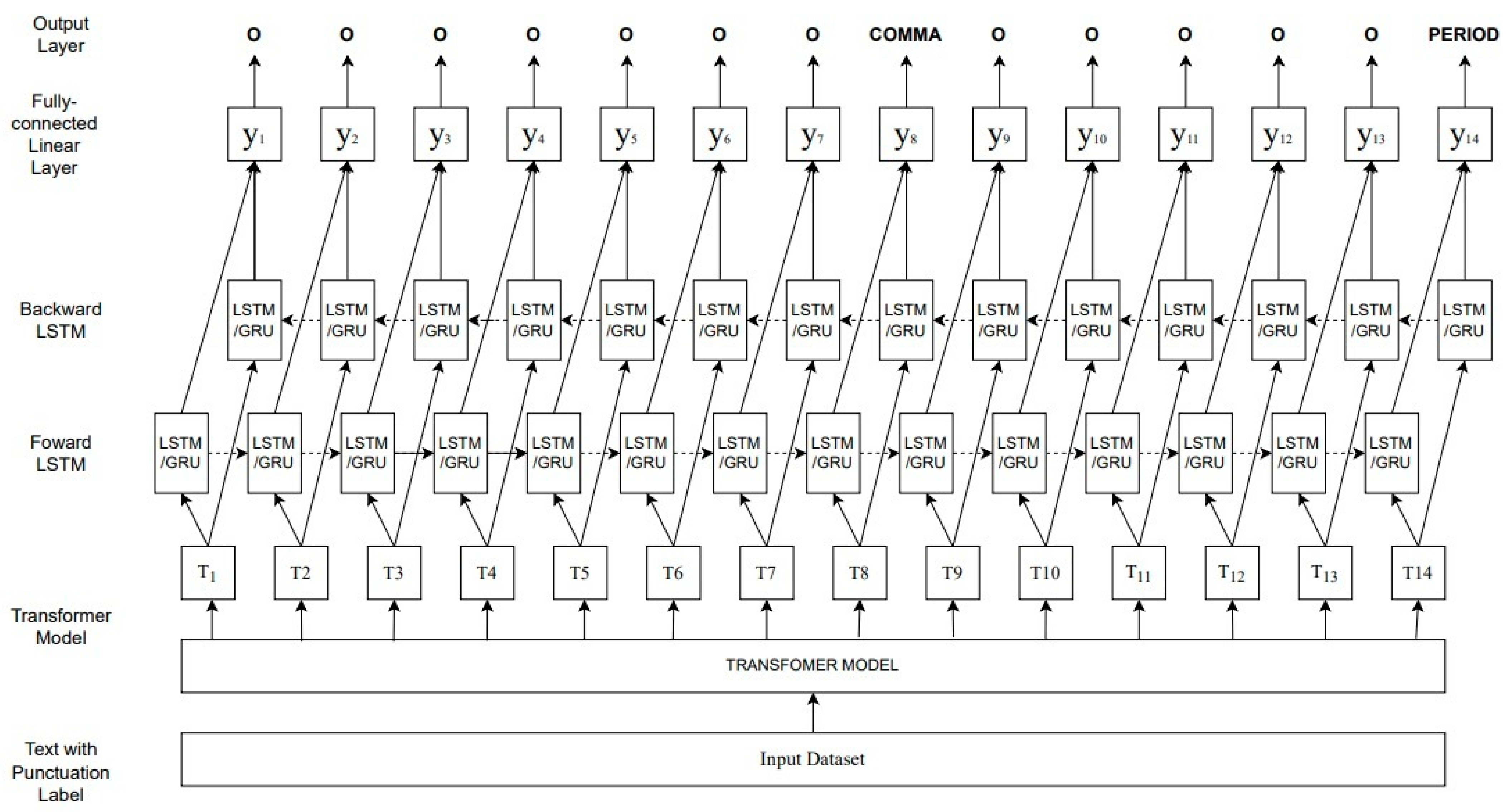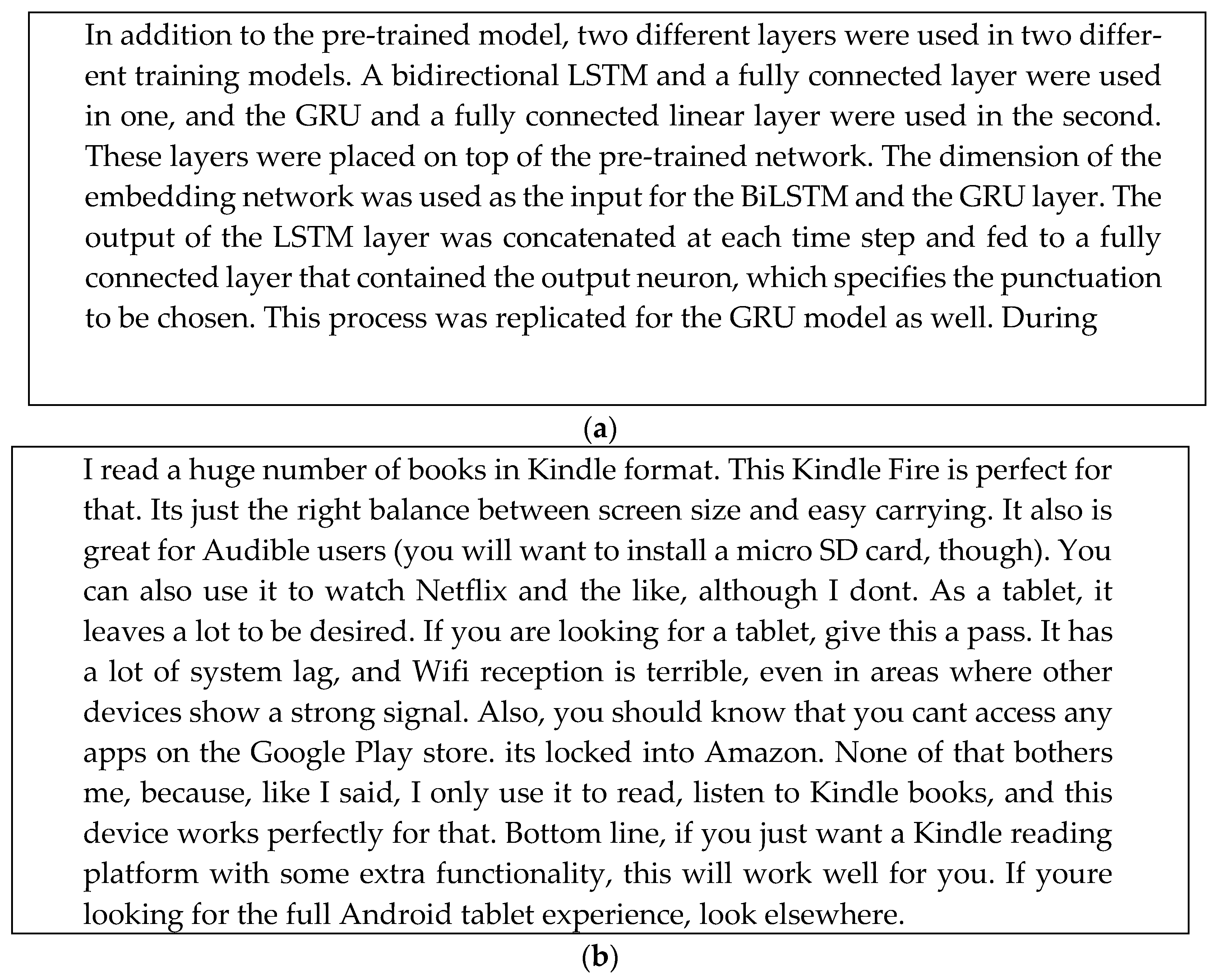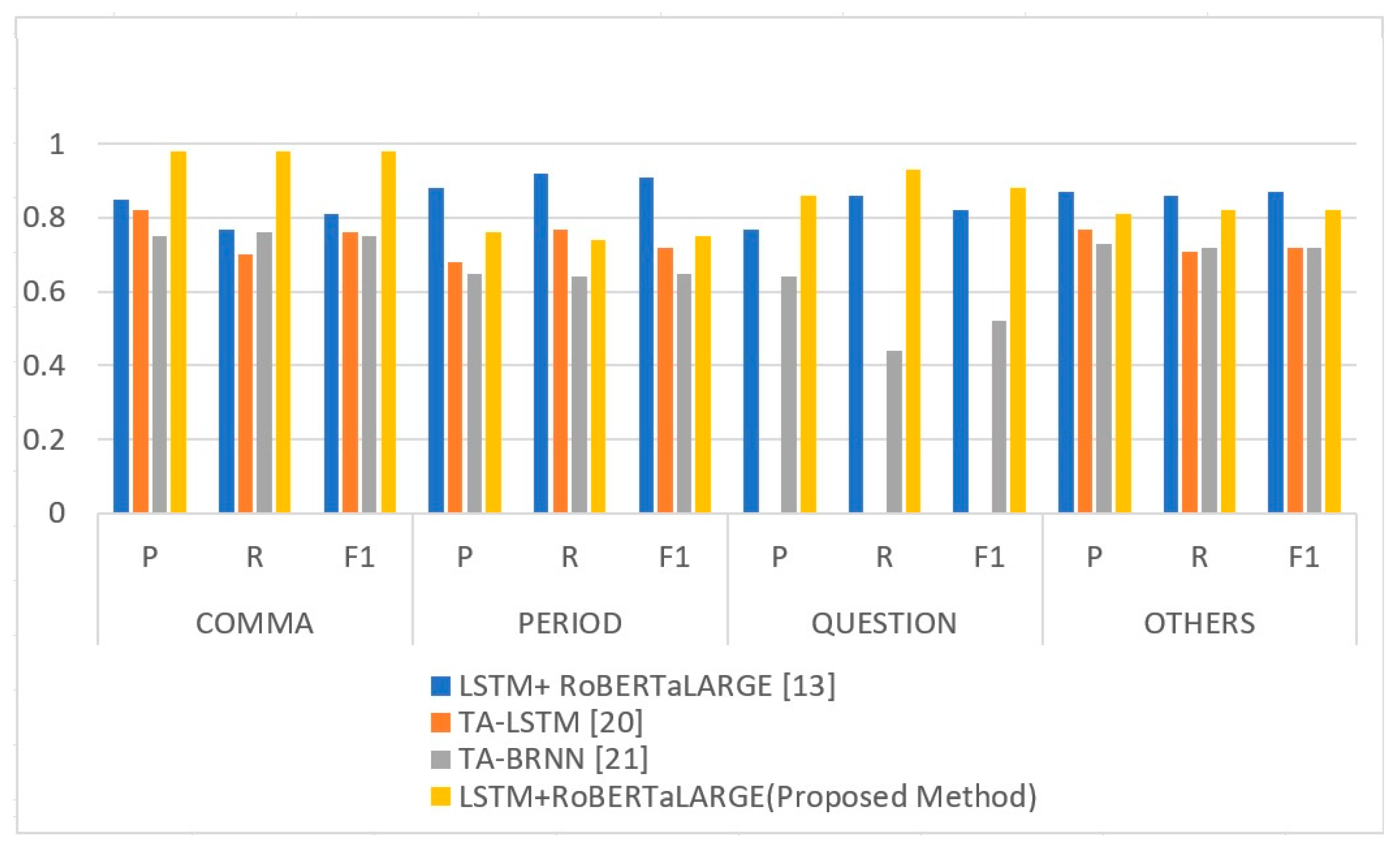Punctuation Restoration with Transformer Model on Social Media Data
Abstract
1. Introduction
2. Related Works
3. Methodology
3.1. Dataset
3.2. Preprocessing
“But no backlight which makes not readable at night.”
[‘But’, ‘no’, ‘backlight’, ‘which’, ‘makes’, ‘not’, ‘readable’, ‘at’, ‘night.’].
[But O no O backlight O which O makes O not O readable O at O night PERIOD].
3.3. Transformer Model
3.4. Architecture
3.4.1. BERT [25]
3.4.2. XLNET [30]
3.4.3. RoBERTa [26]
3.4.4. DistillBERT [31]
3.4.5. AlBERT [32]
3.5. Training
4. Experimental Result
5. Conclusions
Author Contributions
Funding
Institutional Review Board Statement
Informed Consent Statement
Data Availability Statement
Conflicts of Interest
References
- Curran, T.; Treiber, J.; Rosenblatt, M. Building Brands through Social Listening. In Proceedings of the Northeast Business & Economics Association; Northeast Business & Economics Association: Worcester, MA, USA, 2018; pp. 74–78. [Google Scholar]
- Wiener, M.; Hoßbach, N.; Saunders, C. Omnichannel businesses in the publishing and retailing industries: Synergies and tensions between coexisting online and offline business models. Decis. Support Syst. 2018, 109, 15–26. [Google Scholar] [CrossRef]
- Rahat, A.M.; Kahir, A.; Masum, A.K.M. Comparison of Naive Bayes and SVM Algorithm based on Sentiment Analysis Using Review Dataset. In Proceedings of the 2019 8th International Conference System Modeling and Advancement in Research Trends (SMART), Moradabad, India, 22–23 November 2019; IEEE: Piscataway, NJ, USA, 2020; pp. 266–270. [Google Scholar] [CrossRef]
- Anbananthen, K.S.M.; Krishnan, J.K.; Sayeed, M.S.; Muniapan, P. Comparison of stochastic and rule-based POS tagging on Malay online text. Am. J. Appl. Sci. 2017, 14, 843–851. [Google Scholar] [CrossRef]
- Woldemariam, Y. Sentiment analysis in a cross-media analysis framework; Sentiment analysis in a cross-media analysis framework. In Proceedings of the 2016 IEEE International Conference on Big Data Analysis (ICBDA), Hangzhou, China, 12–14 March 2016. [Google Scholar] [CrossRef]
- Dey, L.; Haque, S.K.M. Opinion mining from noisy text data. In Proceedings of the 2nd Workshop on Analytics for Noisy Unstructured Text Data, Singapore, 24 July 2008; pp. 83–90. [Google Scholar] [CrossRef]
- Yuliah, S.; Bandung, P.N.; Purnamasari, Y.; Bandung, P.N.; Yunita, E.; Bandung, P.N. Grammatical Errors in Social Media Caption. Int. J. Lang. Lit. 2020, 8, 17–20. [Google Scholar] [CrossRef]
- Lu, W.; Ng, H.T. Better punctuation prediction with dynamic conditional random fields. In Proceedings of the EMNLP 2010—Conference on Empirical Methods in Natural Language Processing, Cambridge, MA, USA, 9–11 October 2010; pp. 177–186. [Google Scholar]
- Kim, S. Deep Recurrent Neural Networks with Layer-wise Multi-head Attentions for Punctuation Restoration. In Proceedings of the ICASSP 2019—2019 IEEE International Conference on Acoustics, Speech and Signal Processing (ICASSP), Brighton, UK, 12–17 May 2019; pp. 7280–7284. [Google Scholar] [CrossRef]
- Tomanek, K.; Wermter, J.; Hahn, U. Sentence and Token Splitting Based on Conditional Random Fields. In Proceedings of the 10th Conference of the Pacific Association for Computational Linguistics, Melbourne, Australia, 19–21 September 2007; p. 57. Available online: https://pdfs.semanticscholar.org/5651/b25a78ac8fd5dd65f9c877c67897f58cf817.pdf (accessed on 20 June 2022).
- Manning, C.D.; Bauer, J.; Finkel, J.; Bethard, S.J. The Stanford CoreNLP Natural Language Processing Toolkit. Aclweb.Org. 2014, pp. 55–60. Available online: http://aclanthology.org/P14-5010/ (accessed on 20 June 2022).
- Loper, E.; Bird, S. NLTK: The Natural Language Toolkit. In Proceedings of the COLING/ACL on Interactive Presentation Sessions, Sydney, Australia, 17–18 July 2006. [Google Scholar] [CrossRef]
- Alam, T.; Khan, A.; Alam, F. Punctuation Restoration using Transformer Models for High-and Low-Resource Languages. In Proceedings of the Sixth Workshop on Noisy User-generated Text (W-NUT 2020), Online, 19 November 2020; pp. 132–142. [Google Scholar] [CrossRef]
- Che, X.; Wang, C.; Yang, H.; Meinel, C. Punctuation prediction for unsegmented transcript based on Word Vector. In Proceedings of the Tenth International Conference on Language Resources and Evaluation (LREC’16), Marseille, France, 11–16 May 2016; pp. 654–658. [Google Scholar]
- Nguyen, B.; Nguyen, V.B.H.; Nguyen, H.; Phuong, P.N.; Nguyen, T.L.; Do, Q.T.; Mai, L.C. Fast and Accurate Capitalization and Punctuation for Automatic Speech Recognition Using Transformer and Chunk Merging. In Proceedings of the 2019 22nd Conference of the Oriental COCOSDA International Committee for the Co-ordination and Standardisation of Speech Databases and Assessment Techniques (O-COCOSDA), Cebu, Philippines, 25–27 October 2019. [Google Scholar] [CrossRef]
- Păiș, V.; Tufiș, D. Capitalization and Punctuation Restoration: A Survey. Available online: http://mi.eng.cam.ac.uk/research/projects/EARS/ears_summary.html (accessed on 9 September 2022).
- Jansche, M.; Bacchiani, M. Restoring Punctuation and Capitalization in Transcribed Speech; Department of Computer Science, Columbia University: New York, NY, USA, 2009; pp. 4741–4744. [Google Scholar]
- Miranda, J.; Neto, J.P.; Black, A.W. Improved punctuation recovery through combination of multiple speech streams. In Proceedings of the 2013 IEEE Workshop on Automatic Speech Recognition and Understanding, Olomouc, Czech Republic, 8–12 December 2013; pp. 132–137. [Google Scholar] [CrossRef]
- Lui, M.; Wang, L. Recovering Casing and Punctuation using Conditional Random Fields. In Proceedings of the Australasian Language Technology Association Workshop 2013 (ALTA 2013), Brisbane, Australia, 4–6 December 2013; pp. 137–141. Available online: http://www.aclweb.org/anthology/U13-1020 (accessed on 19 July 2022).
- Tilk, O.; Alumäe, T. LSTM for punctuation restoration in speech transcripts. In Proceedings of the Sixteenth Annual Conference of the International Speech Communication Association—INTERSPEECH, Dresden, Germany, 6–10 September 2015; pp. 683–687. [Google Scholar] [CrossRef]
- Tilk, O.; Alumäe, T. Bidirectional recurrent neural network with attention mechanism for punctuation restoration. In Proceedings of the Annual Conference of the International Speech Communication Association—INTERSPEECH, San Francisco, CA, USA, 8–12 September 2016; pp. 3047–3051. [Google Scholar] [CrossRef]
- Tündik, M.A.; Szaszák, G. Joint Word- and Character-level Embedding CNN-RNN Models for Punctuation Restoration. In Proceedings of the 2018 9th IEEE International Conference on Cognitive Infocommunications (CogInfoCom), Budapest, Hungary, 22–24 August 2018; IEEE: Piscataway, NJ, USA, 2019; pp. 135–140. [Google Scholar] [CrossRef]
- Zelasko, P.; Szymanski, P.; Mizgajski, J.; Szymczak, A.; Carmiel, Y.; Dehak, N. Punctuation prediction model for conversational speech. In Proceedings of the Annual Conference of the International Speech Communication Association—INTERSPEECH, Hyderabad, India, 2–6 September 2018; pp. 2633–2637. [Google Scholar] [CrossRef]
- Ramprasath, M.; Dhanasekaran, K.; Karthick, T.; Velumani, R.; Sudhakaran, P. An Extensive Study on Pretrained Models for Natural Language Processing Based on Transformers; An Extensive Study on Pretrained Models for Natural Language Processing Based on Transformers. In Proceedings of the 2022 International Conference on Electronics and Renewable Systems (ICEARS), Tuticorin, India, 16–18 March 2022. [Google Scholar] [CrossRef]
- Devlin, J.; Chang, M.W.; Lee, K.; Toutanova, K. BERT: Pre-training of deep bidirectional transformers for language understanding. In Proceedings of the NAACL HLT 2019—2019 Conference of the North American Chapter of the Association for Computational Linguistics: Human Language Technologies, Minneapolis, MN, USA, 2–7 June 2019; Volume 1, pp. 4171–4186. [Google Scholar]
- Liu, Y.; Ott, M.; Goyal, N.; Du, J.; Joshi, M.; Chen, D.; Levy, O.; Lewis, M.; Zettlemoyer, L.; Stoyanov, V. RoBERTa: A Robustly Optimized BERT Pretraining Approach. arXiv 2019, arXiv:1907.11692. [Google Scholar]
- Datafiniti. Consumer Reviews Amazon Product—Dataset by Datafiniti. Data World. April 2019. Available online: https://data.world/datafiniti/consumer-reviews-of-amazon-productsproducts (accessed on 10 May 2022).
- Kalaiarasi, S.M.A.; Surendran, S.; Jaya Kumar, K. The Generation of Malay Lexicon. Am. J. Appl. Sci. 2017, 14, 503–510. [Google Scholar]
- Vaswani, A. Attention Is All You Need. no. Nips. 2017. Available online: https://arxiv.org/abs/1706.03762 (accessed on 20 June 2021).
- Dai, Z.; Yang, Z.; Yang, Y.; Carbonell, J.; Le, Q.V.; Salakhutdinov, R. Transformer-XL: Attentive language models beyond a fixed-length context. In Proceedings of the ACL 2019—57th Annual Meeting of the Association for Computational Linguistics, Florence, Italy, 28 July–2 August 2019; Association for Computational Linguistics: Stroudsburg, PA, USA, 2020; pp. 2978–2988. [Google Scholar] [CrossRef]
- Sanh, V.; Debut, L.; Chaumond, J.; Wolf, T. DistilBERT, a distilled version of BERT: Smaller, faster, cheaper and lighter. arXiv 2019, arXiv:1910.01108v4. [Google Scholar]
- Lan, Z.; Chen, M.; Goodman, S.; Gimpel, K.; Sharma, P.; Soricut, R. ALBERT: A Lite BERT for Self-supervised Learning of Language Representations. arXiv 2019, arXiv:1909.11942. [Google Scholar]




| Text—Before Splitting | Polarity |
|---|---|
| I use this every day on my commute. Great battery life. I like the built-in dictionary. It is easy to transfer using pdf format through email or mobile files. But no backlight which makes not readable at night. | Positive |
| Text—After Splitting | Polarity |
|---|---|
| I use this every day on my commute. Great battery life. I like the built-in dictionary. It is easy to transfer using pdf format through email or mobile files. But no backlight which makes not readable at night. | Neutral Positive Positive Positive Negative |
| Text | Polarity |
|---|---|
| The shoe is responsive and that is good but it would be better to have longer shoe laces. | Positive |
| Text | Polarity |
|---|---|
| The shoe is responsive and that is good. But it would be better to have longer shoe laces. | Positive Negative |
| Dataset | Amazon Products Reviews | Telekom Malaysia (TM) Reviews |
|---|---|---|
| Total Reviews | 34,659 | 500 |
| Total Words | 990,326 | 13,317 |
| COMMA | 26,148 | 251 |
| PERIOD | 72,076 | 730 |
| QUESTION | 271 | 21 |
| OTHERS | 891,831 | 12,315 |
| Model | Comma | Period | Question | Others | Training Acc | ||||||||
|---|---|---|---|---|---|---|---|---|---|---|---|---|---|
| P | R | F1 | P | R | F1 | P | R | F1 | P | R | F1 | ||
| LSTM+BERTBASE | 0.65 | 0.14 | 0.23 | 0.63 | 0.53 | 0.58 | 0.64 | 0.31 | 0.41 | 0.91 | 0.99 | 0.95 | 0.90 |
| LSTM+BERTLARGE | 0.47 | 0.27 | 0.34 | 0.75 | 0.20 | 0.32 | 0.55 | 0.23 | 0.33 | 0.91 | 0.99 | 0.95 | 0.89 |
| LSTM+XLNetBASE | 0.48 | 0.26 | 0.34 | 0.85 | 0.17 | 0.28 | 0.56 | 0.21 | 0.31 | 0.90 | 0.99 | 0.94 | 0.88 |
| LSTM+XLNetLARGE | 0.46 | 0.38 | 0.42 | 0.86 | 0.20 | 0.33 | 0.54 | 0.29 | 0.34 | 0.92 | 0.99 | 0.96 | 0.89 |
| LSTM+AlBERTBASE | 0.60 | 0.15 | 0.24 | 0.62 | 0.53 | 0.57 | 0.62 | 0.31 | 0.42 | 0.92 | 0.99 | 0.96 | 0.89 |
| LSTM+RoBERTaBASE | 0.41 | 0.28 | 0.33 | 0.85 | 0.06 | 0.11 | 0.44 | 0.17 | 0.25 | 0.90 | 0.99 | 0.95 | 0.88 |
| LSTM+RoBERTaLARGE | 0.77 | 0.70 | 0.73 | 0.83 | 0.86 | 0.84 | 0.80 | 0.78 | 0.79 | 0.98 | 0.99 | 0.98 | 0.95 |
| LSTM+ DistilBERTBASE | 0.45 | 0.05 | 0.09 | 0.72 | 0.05 | 0.09 | 0.53 | 0.04 | 0.08 | 0.87 | 0.99 | 0.92 | 0.86 |
| GRU+ BERTBASE | 0.42 | 0.23 | 0.30 | 0.62 | 0.16 | 0.25 | 0.49 | 0.19 | 0.27 | 0.91 | 0.99 | 0.95 | 0.89 |
| GRU+ BERTLARGE | 0.46 | 0.17 | 0.25 | 0.75 | 0.19 | 0.31 | 0.58 | 0.18 | 0.27 | 0.90 | 0.99 | 0.95 | 0.89 |
| GRU+ XLNetBASE | 0.45 | 0.33 | 0.38 | 0.85 | 0.16 | 0.27 | 0.52 | 0.24 | 0.33 | 0.91 | 0.99 | 0.95 | 0.89 |
| GRU+ XLNetLARGE | 0.42 | 0.41 | 0.42 | 0.89 | 0.06 | 0.11 | 0.45 | 0.24 | 0.31 | 0.92 | 0.99 | 0.96 | 0.89 |
| GRU+AlBERTBASE | 0.62 | 0.32 | 0.42 | 0.71 | 0.57 | 0.66 | 0.67 | 0.42 | 0.52 | 0.93 | 0.99 | 0.96 | 0.91 |
| GRU+AlBERTLARGE | 0.47 | 0.23 | 0.04 | 0.60 | 0.31 | 0.41 | 0.59 | 0.15 | 0.24 | 0.87 | 0.99 | 0.94 | 0.88 |
| GRU+RoBERTaBASE | 0.45 | 0.36 | 0.40 | 0.78 | 0.14 | 0.23 | 0.50 | 0.25 | 0.33 | 0.92 | 0.99 | 0.95 | 0.89 |
| GRU+RoBERTaLARGE | 0.77 | 0.71 | 0.74 | 0.83 | 0.87 | 0.85 | 0.79 | 0.78 | 0.79 | 0.98 | 0.99 | 0.98 | 0.96 |
| GRU+DistilBERTBASE | 0.41 | 0.18 | 0.25 | 0.66 | 0.10 | 0.17 | 0.47 | 0.17 | 0.21 | 0.90 | 0.99 | 0.94 | 0.87 |
| Model | Comma | Period | Question | Others | Testing Acc | ||||||||
|---|---|---|---|---|---|---|---|---|---|---|---|---|---|
| P | R | F1 | P | R | F1 | P | R | F1 | P | R | F1 | ||
| LSTM+BERTBASE | 0.63 | 0.13 | 0.22 | 0.61 | 0.48 | 0.54 | 0.61 | 0.30 | 0.40 | 0.92 | 0.99 | 0.96 | 0.90 |
| LSTM+BERTLARGE | 0.48 | 0.27 | 0.35 | 0.73 | 0.20 | 0.32 | 0.56 | 0.23 | 0.33 | 0.91 | 0.99 | 0.95 | 0.89 |
| LSTM+XLNetBASE | 0.44 | 0.21 | 0.29 | 0.83 | 0.17 | 0.19 | 0.55 | 0.20 | 0.28 | 0.91 | 0.99 | 0.95 | 0.89 |
| LSTM+XLNetLARGE | 0.45 | 0.40 | 0.41 | 0.84 | 0.29 | 0.32 | 0.54 | 0.28 | 0.37 | 0.93 | 0.99 | 0.96 | 0.90 |
| LSTM+AlBERTBASE | 0.60 | 0.17 | 0.26 | 0.60 | 0.48 | 0.53 | 0.60 | 0.31 | 0.41 | 0.92 | 0.99 | 0.96 | 0.90 |
| LSTM+RoBERTaBASE | 0.41 | 0.27 | 0.33 | 0.84 | 0.07 | 0.12 | 0.45 | 0.16 | 0.24 | 0.91 | 0.99 | 0.95 | 0.89 |
| LSTM+RoBERTaLARGE | 0.77 | 0.75 | 0.76 | 0.86 | 0.91 | 0.88 | 0.81 | 0.83 | 0.82 | 0.99 | 0.99 | 0.99 | 0.97 |
| LSTM+ DistilBERTBASE | 0.42 | 0.04 | 0.07 | 0.62 | 0.07 | 0.12 | 0.53 | 0.05 | 0.09 | 0.87 | 0.99 | 0.94 | 0.87 |
| GRU+ BERTBASE | 0.43 | 0.24 | 0.30 | 0.62 | 0.16 | 0.25 | 0.49 | 0.19 | 0.27 | 0.91 | 0.99 | 0.95 | 0.89 |
| GRU+ BERTLARGE | 0.46 | 0.17 | 0.25 | 0.75 | 0.19 | 0.31 | 0.58 | 0.18 | 0.27 | 0.90 | 0.99 | 0.95 | 0.90 |
| GRU+ XLNetBASE | 0.46 | 0.33 | 0.39 | 0.80 | 0.16 | 0.26 | 0.53 | 0.24 | 0.33 | 0.92 | 0.99 | 0.96 | 0.90 |
| GRU+ XLNetLARGE | 0.42 | 0.42 | 0.42 | 0.92 | 0.07 | 0.14 | 0.45 | 0.21 | 0.31 | 0.93 | 0.99 | 0.96 | 0.90 |
| GRU+AlBERTBASE | 0.57 | 0.34 | 0.42 | 0.72 | 0.54 | 0.62 | 0.66 | 0.43 | 0.51 | 0.94 | 0.99 | 0.97 | 0.91 |
| GRU+AlBERTLARGE | 0.48 | 0.03 | 0.05 | 0.59 | 0.30 | 0.40 | 0.58 | 0.16 | 0.25 | 0.89 | 0.99 | 0.94 | 0.89 |
| GRU+RoBERTaBASE | 0.48 | 0.36 | 0.41 | 0.75 | 0.16 | 0.27 | 0.54 | 0.25 | 0.35 | 0.92 | 0.99 | 0.96 | 0.89 |
| GRU+RoBERTaLARGE | 0.76 | 0.76 | 0.76 | 0.87 | 0.91 | 0.88 | 0.82 | 0.84 | 0.83 | 0.99 | 0.99 | 0.99 | 0.95 |
| GRU+DistilBERTBASE | 0.41 | 0.19 | 0.25 | 0.66 | 0.10 | 0.17 | 0.47 | 0.14 | 0.21 | 0.90 | 0.99 | 0.95 | 0.88 |
| Model | Comma | Period | Question | Others | Testing Acc | ||||||||
|---|---|---|---|---|---|---|---|---|---|---|---|---|---|
| P | R | F1 | P | R | F1 | P | R | F1 | P | R | F1 | ||
| LSTM+BERTBASE | 0.36 | 0.07 | 0.12 | 0.59 | 0.54 | 0.56 | 0.57 | 0.44 | 0.59 | 0.95 | 0.97 | 0.96 | 0.92 |
| LSTM+BERTLARGE | 0.36 | 0.07 | 0.12 | 0.59 | 0.54 | 0.56 | 0.57 | 0.44 | 0.59 | 0.95 | 0.97 | 0.96 | 0.93 |
| LSTM+XLNetBASE | 0.34 | 015 | 0.21 | 0.62 | 0.63 | 0.63 | 0.60 | 0.53 | 0.56 | 0.95 | 0.97 | 0.96 | 0.93 |
| LSTM+XLNetLARGE | 0.34 | 015 | 0.21 | 0.50 | 0.62 | 0.63 | 0.57 | 0.55 | 0.56 | 0.95 | 0.94 | 0.96 | 0.92 |
| LSTM+AlBERTBASE | 0.04 | 0.12 | 0.06 | 0.45 | 0.42 | 0.43 | 0.29 | 0.35 | 0.32 | 0.95 | 0.93 | 0.94 | 0.88 |
| LSTM+RoBERTaBASE | 0.21 | 0.14 | 0.17 | 0.65 | 0.48 | 0.55 | 0.57 | 0.40 | 0.47 | 095 | 0.97 | 0.96 | 0.93 |
| LSTM+RoBERTaLARGE | 0.13 | 0.40 | 0.20 | 0.46 | 0.80 | 0.59 | 0.35 | 0.70 | 0.46 | 0.99 | 0.90 | 0.94 | 0.91 |
| LSTM+DistilBERTBASE | 0.29 | 0.04 | 0.07 | 0.62 | 0.41 | 0.49 | 0.60 | 0.33 | 0.43 | 0.94 | 0.98 | 0.96 | 0.93 |
| GRU+ BERTBASE | 0.27 | 0.16 | 0.20 | 0.60 | 0.55 | 0.58 | 0.56 | 0.46 | 0.51 | 0.95 | 0.97 | 0.96 | 0.93 |
| GRU+ BERTLARGE | 0.27 | 0.12 | 0.17 | 0.61 | 0.57 | 0.59 | 0.58 | 0.48 | 0.52 | 0.95 | 0.97 | 0.96 | 0.93 |
| GRU+ XLNetBASE | 0.39 | 0.13 | 0.20 | 0.63 | 0.65 | 0.64 | 0.62 | 0.54 | 0.57 | 0.96 | 0.97 | 0.96 | 0.93 |
| GRU+ XLNetLARGE | 0.34 | 015 | 0.21 | 0.50 | 0.62 | 0.63 | 0.57 | 0.55 | 0.56 | 0.95 | 0.94 | 0.96 | 0.92 |
| GRU+AlBERTBASE | 0.07 | 0.12 | 0.09 | 0.58 | 0.33 | 0.42 | 0.37 | 0.28 | 0.32 | 0.94 | 0.96 | 0.95 | 0.90 |
| GRU+AlBERTLARGE | 0.08 | 0.02 | 0.03 | 0.46 | 0.11 | 0.18 | 0.40 | 0.09 | 0.15 | 0.92 | 0.99 | 0.95 | 0.91 |
| GRU+RoBERTaBASE | 0.28 | 0.17 | 0.21 | 0.63 | 0.57 | 0.60 | 0.60 | 0.48 | 0.52 | 0.95 | 0.97 | 0.96 | 0.93 |
| GRU+RoBERTaLARGE | 0.15 | 0.42 | 0.20 | 0.46 | 0.80 | 0.59 | 0.45 | 0.70 | 0.56 | 0.99 | 0.95 | 0.95 | 0.90 |
| GRU+DistilBERTBASE | 0.27 | 0.11 | 0.16 | 0.61 | 0.47 | 0.53 | 0.57 | 0.39 | 0.47 | 0.95 | 0.97 | 0.96 | 0.93 |
| Evaulation Criteria | Comma | Period | Question | Others |
|---|---|---|---|---|
| Precision | LSTM+RoBERTaLARGE | GRU+RoBERTaLARGE | GRU+RoBERTaLARGE | LSTM+RoBERTaLARGE |
| Recall | LSTM+RoBERTaLARGE | LSTM+RoBERTaLARGE | GRU+RoBERTaLARGE | LSTM+RoBERTaLARGE |
| F1 | LSTM+RoBERTaLARGE | LSTM+RoBERTaLARGE | GRU+RoBERTaLARGE | LSTM+RoBERTaLARGE |
Disclaimer/Publisher’s Note: The statements, opinions and data contained in all publications are solely those of the individual author(s) and contributor(s) and not of MDPI and/or the editor(s). MDPI and/or the editor(s) disclaim responsibility for any injury to people or property resulting from any ideas, methods, instructions or products referred to in the content. |
© 2023 by the authors. Licensee MDPI, Basel, Switzerland. This article is an open access article distributed under the terms and conditions of the Creative Commons Attribution (CC BY) license (https://creativecommons.org/licenses/by/4.0/).
Share and Cite
Bakare, A.M.; Anbananthen, K.S.M.; Muthaiyah, S.; Krishnan, J.; Kannan, S. Punctuation Restoration with Transformer Model on Social Media Data. Appl. Sci. 2023, 13, 1685. https://doi.org/10.3390/app13031685
Bakare AM, Anbananthen KSM, Muthaiyah S, Krishnan J, Kannan S. Punctuation Restoration with Transformer Model on Social Media Data. Applied Sciences. 2023; 13(3):1685. https://doi.org/10.3390/app13031685
Chicago/Turabian StyleBakare, Adebayo Mustapha, Kalaiarasi Sonai Muthu Anbananthen, Saravanan Muthaiyah, Jayakumar Krishnan, and Subarmaniam Kannan. 2023. "Punctuation Restoration with Transformer Model on Social Media Data" Applied Sciences 13, no. 3: 1685. https://doi.org/10.3390/app13031685
APA StyleBakare, A. M., Anbananthen, K. S. M., Muthaiyah, S., Krishnan, J., & Kannan, S. (2023). Punctuation Restoration with Transformer Model on Social Media Data. Applied Sciences, 13(3), 1685. https://doi.org/10.3390/app13031685






